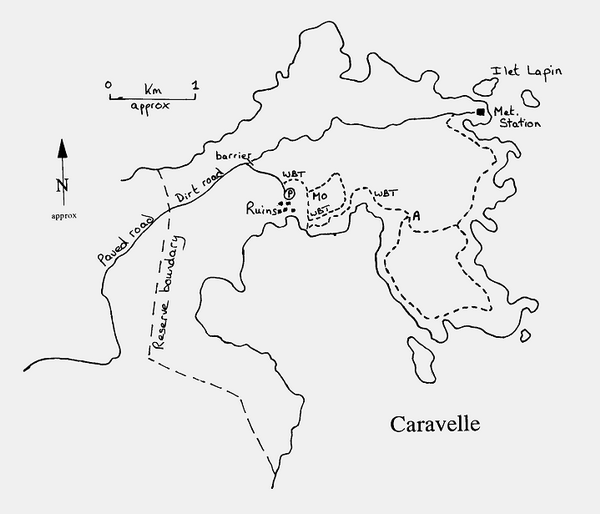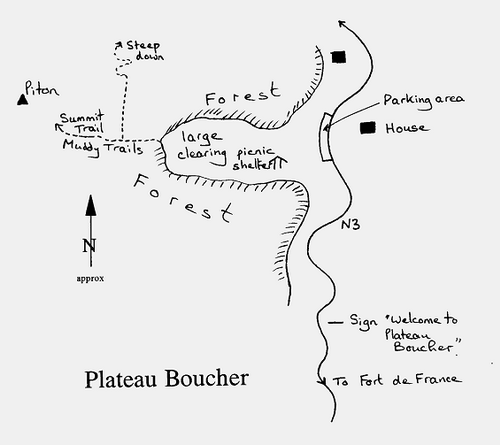Section 1 - Introduction, logistics, itinerary and general information.
Section 2 - Birding sites (Martinique).
Section 3 - Birding sites (Guadeloupe).
Section 4 - Birding sites (Dominica).
Section 5 - Birding sites (St. Lucia).
Section 6 - Annotated checklist.
Birding Sites
Included below are details of access, habitat and species observed for all sites visited. A 'c' denotes that the bird was common or fairly so. Bold typeface identifies species of particular note; either rare, endemic, or which might be considered a target bird at that locality. Due to the limited time on each island, most sites were chosen to find key endemics. A few others were visited speculatively.
Martinique
Martinique has one single-island endemic; the Martinique Oriole. However, three other species occurring on Martinique are found only on one other island. These species are the Martinique Thrasher (St. Lucia), Blue-headed Sunbird (Dominica), and Grey Trembler (St. Lucia).
|
Although the thrasher is more numerous on St. Lucia, its occurs there in a rather remote location, and is consequently much easier to find on Martinique. Conversely, the Trembler, rare on Martinique, is more readily seen on St. Lucia. The Blue-headed Sunbird appears to be locally fairly common on both islands, although we only saw one. Having stayed with friends, I have no personal recommendations for accommodation on Martinique. Given the good state of the roads and the small size of the island, it would seem to matter little where one might use as a base. In the past, birders concentrating on finding the Martinique Oriole in the south-western part of the island, have stayed at the Diamant Bleu in Diamant, or the Hotel de la Pagerie in Pointe d'Bout. However, birders now visiting Caravelle and central Martinique might consider staying nearer Fort de France. The Lonely Planet guide offers numerous suggestions. Although, apparently not well known, the Fer-de-Lance has been introduced on Martinique as on other islands in the area. |
Martinique 1. Caravelle. Alt. 0-50m.
The Réserve Naturelle de la Caravelle, to give it the official title, covers the end third of the Caravelle Peninsula, which juts out of the northeast coast. This reserve is the last refuge to the critically endangered White-breasted Thrasher, around 40 pairs of which still hold on.
The habitat is a mixture of dry woodland and mangroves, with scrub on the open headlands. Even within this small area, owing to its highly specific habitat requirement, the Thrasher is extremely localised. The bird appears to be found almost exclusively along the bottom of dry, well-wooded ravines with an open understorey where it feeds on the floor turning over leaf-litter. The best place to search, where the bird seems fairly common, is along the trails just to the east of the Ruines du Chateau Dubuc. |
|
On arrival at the Caravelle Peninsula (easily found using a road map) continue to the end of the gravel, access road to the small parking area (marked 'P' on the map) at the entrance to the ruins. About 30 metres before the entrance you will find a large overview map and the starting point for all the trails. Walk the short circular trail and you are almost sure to find several Martinique Thrasher - marked WBT on map. Additionally, this is one of the best places on Martinique to search for the Martinique Oriole. About 200 metres from the start of the trail you will come to a large board with information and poor illustrations of the Oriole - by some coincidence the trees in this area are a favourite haunt, so it is worth spending some time in this area (marked MO on map). If by some ill-fortune the thrasher cannot be found here, continue walking the trail running south beside the ruins and continue parallel to the southern coast as far as the next fork (marked 'A' on map), where the cross-peninsula trail leads off.
To enter the ruins a small fee of 10 Fr is payable. These are quite pleasant, and offer views into some of the surrounding taller trees. Interesting seabirds, both resident and migrant, can be found all along the rocky coasts of the eastern side of the peninsula. Ilet Lapin, just offshore from the meteorological station, has breeding Bridled Tern. Sooty Tern can sometimes be seen. Red-billed Tropicbird breeds in small numbers among the cliffs of the southeast corner of the peninsula. To walk the complete circuit from the ruins, around the peninsula, and back along the meteorological station access road takes about three hours solid walking -carry food and water. No food or drinks are available within the Reserve, but several restaurants, and shops can be found just outside, along the road and beach at Anse l'Etang.
Species recorded at Caravelle:
Red-billed Tropicbird 6+ |
Caribbean Elaenia c |
Martinique 2. La Demarché. Alt. 500 m.
La Demarché, a short distance from Fort de France, is a recreational and hiking area on the opposite side of the Pitons du Carbet to Plateau Boucher (below). The habitat is hacked-over, mid-elevation forest, and can be worked easily in half a day. Rufous-throated Solitaire is common. Other possibilities include Lesser Antillean Pewee, Blue-headed Hummingbird and Martinique Oriole. The habitat looks as though the Grey Trembler should occur, but it has yet to be recorded. Might the elevation be too low? Take the N2, coastal road, northward from Fort de France toward Case-Pilote and Saint Pierre. A kilometre or two before Case-Pilote take a right turn, inland, signposted to La Demarché. The road is steep and narrow, but paved. Drive the few kilometres to the very end of the road and park. The habitat in this immediate vicinity is very unexciting cattle pasture, and it is necessary to walk a kilometre or so to access the forest. Follow the only trail in a generally northerly direction, using the Pitons du Carbet, which dominate the horizon, as a heading. After a half hour climb through agriculture, the trail runs along a forested ridge, which is the main area to bird. We only worked the first 500 metres of the ridge, though a trial system extends far beyond - probably right around the Pitons.
Species recorded at La Demarché:
Broad-winged Hawk 2 |
Bare-eyed Thrush 4+ |
Martinique 3. Plateau Boucher. Alt. 680 m.
Plateau Boucher, in northern central Martinique, with good access to montane rainforest, offers the opportunity to locate several of the rarer, interesting species. This is probably the best place to find the Rufous-throated Solitaire, Blue-headed Hummingbird and Grey Trembler, though the later is as rare here as everywhere on Martinique. Other possibilities are Lesser Antillean Swift and Martinique Oriole. In theory the Blue-headed Hummingbird is fairly common here, though we failed to see any - possibly because of breeding at this time of year.
|
Access is easy, as the plateau is traversed by the N3 "Route de la Trace". It is also a weekend recreational area, though apparently little frequented. Those feeling adventurous can climb the steep hiking trial to the summit of Piton de Carbet at 1,120 metres. The ascent takes about an hour. Birding can be done from the road, but should concentrate around the picnic site, and along the forest trails. We saw a pair of Grey Trembler in the tall trees immediately adjacent to the picnic shelter (see map). From Fort de France take the N3 northward. After ten or so kilometres this winding road levels out slightly, and a sign indicates arrival on the Plateau Boucher (Bienvenue à Plateau Boucher or something similar) . A few hundred metres past this sign you come to a large pull-in and picnic area on the left, west, side of the road. Park and explore. |
Species recorded at Plateau Boucher:
Ruddy Quail-Dove 2+ |
Grey Trembler 2 |
Martinique 4. La Manzo Reservoir.
As Martinique lacks any good wetland habitat, this man-made reservoir is the most likely place to find waterbirds on the island. However, hunting pressures, poor vegetation and disturbance make finding wildfowl the exception rather than the rule. Both Caribbean Coot and American Coot occur, though both are rare and probably only migrant visitors. It's worth a short roadside stop if passing, but do not expect great things. The reservoir is about 15 kilometres east of Fort de France, and can be viewed from the N6 Fort de France to Le François road.
Species recorded at La Manzo Reservoir:
Pied-billed Grebe 10+ |
Tropical Mockingbird 2 |
Martinique 5. Other possibilities.
In the past birders have worked the dry scrub around Diamant in the southwest, a traditional site for the Martinique Oriole. See the ICBP study report 23 (ICBP, 1986) for details of other areas where the oriole might be found. A large part of the extreme north of Martinique, on the slopes of Mt. Pelee, is kept as a wilderness area and must hold interesting birds. Like all of the caribbean islands, Martinique has many offshore islets which hold breeding seabird colonies.
Section 1 - Introduction, logistics, itinerary and general information.
Section 2 - Birding sites (Martinique).
Section 3 - Birding sites (Guadeloupe).
Section 4 - Birding sites (Dominica).
Section 5 - Birding sites (St. Lucia).
Section 6 - Annotated checklist.



